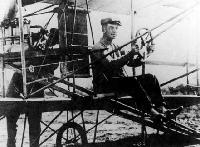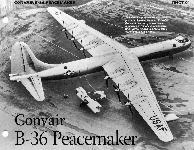
Варианты
- Curtiss - Golden Flyer / Model D - 1909 - США
- Feng Ru - No 1/No 2 - 1910 - Китай
Curtiss Model D и Model Е
К середине 1911 года все "Curtiss Pusher" были приведены к общему стандарту и выпускались серийно. С этого момента Кертис внедрил новую систему обозначений своих аэропланов - это требовалось для более эффективной рекламной кампании. К настоящему времени не сохранилось информации о том, каким образцам были присвоены обозначения Model A, Model В и Model С, если они вообще были использованы Кертисом, поэтому первыми документально подтвержденными самолетами американского конструктора и предпринимателя являются Model D и Model Е.
Армия и ВМС США приобрели 12 самолетов "Curtiss Pusher" берегового базирования в 1911 и 1912 годах, но только один из них принадлежал к типу Model D - это был аэроплан модификации Model D-8. Единственным аппаратом Model D, поступившим на вооружение в США, стал второй заказанный Армией США самолет - его приобрели в марте 1911 года и получили в том же месяце, после чего самолет получил обозначение Signal Corps Aeroplane No. 2. Вскоре его оснастили новым двигателем Curtiss мощностью 40 л.с., а затем убрали передний руль высоты. В феврале 1914 года Армия США прекратила летную эксплуатацию всех своих учебных самолетов с толкающим винтом, и свою карьеру этот аэроплан закончил в роли учебной машины, прозванной "Пингвином", поскольку у него были обрезаны крылья, чтобы самолет не смог взлететь. Другими двумя модификациями данного аэроплана были Model D-4 с рядным четырехцилиндровым двигателем Curtiss мощностью 40 л.с. и Model D-8-75 с V-образным восьмицилиндровым двигателем Curtiss мощностью 75 л.с.
Самолет Model Е был несколько больше, строились модификации Model Е-4, Model Е-8 и Model E-8-75 с аналогичными таким же модификациям двигателями.
Армия США заказала три самолета модификации Model Е-4 - они стали 6-м, 8-м и 23-м аэропланами, приобретенными американской Армией. Силовая установка самолетов считалась маломощной, поэтому машины эксплуатировались преимущественно в одноместном варианте. Была предпринята попытка модернизировать самолет, 40-сильный двигатель заменили на 60-сильный, установленный до того на единственном военном Model D-8. Второй аэроплан затем переделали под гидросамолет, а третья машина была снята с вооружения и продана в 1914 году. Впрочем, в том же году все самолеты были сняты с вооружения из-за большого количества поломок и многочисленных нареканий со стороны специалистов летного отряда Армии США в Норт-Айленде, около Сан-Диего, штат Калифорния.
ТАКТИКО-ТЕХНИЧЕСКИЕ ХАРАКТЕРИСТИКИ
Curtiss Model D-8
Тип: одноместный аэроплан
Силовая установка: один V-образный ПД Curtiss мощностью 60 л.с. (45 кВт)
Летные характеристики: макс, скорость на уровне моря 96,5 км/час
Масса: максимальная взлетная 295 кг
Размеры: размах крыла 10,16 м; длина 7,85 м; высота 2,27 м
- Описание
Фотографии
-
Aeroplane Monthly 1998-12 / M.Vines - Rhinebeck revisites /Circus flying/
Karl Erickson airborne in the exposed pilot’s seat of the Curtiss D pusher. The shoulder yoke via which the ailerons are operated is clearly visible. An 80 h.p. Hall-Scott engine provides the power.
-
Aeroplane Monthly 1993-11 / M.Oakey - Grapevine
Mike Beach taxies his Curtiss Pusher at Brooklands on September 18, 1993.
-
Aeroplane Monthly 1999-09 / M.Oakey, T.Harmsworth - News
Now on display at Kermit Weeks’s Fantasy of Flight Museum at Polk City, Florida, is the Curtiss Pusher replica constructed by Mike Beach. It was formerly on show at the Brooklands Museum.
-
Air Enthusiast 1992-12 / P.Corley-Smith - Birdmen of British Columbia
Charles Hamilton's Curtiss pusher biplane at Minoru Park, March 25, 1910.
-
Air Enthusiast 1992-12 / P.Corley-Smith - Birdmen of British Columbia
Charles Hamilton in the air. Minoru Park, March 26, 1910.
-
Мировая Авиация 96
Самолет, приобретенный и обозначенный Армией США как Aeroplane No. 6, представлял собой машину типа Curtiss Model Е. Он эксплуатировался в одноместном варианте из-за малой мощности силовой установки.
Curtiss Trainer SC-2 in which Kelly and Park were killed in separate incidents. -
Мировая Авиация 53
Первый авиатор ВМС США. 23 декабря 1910г.: лейтенант Теодор Эллисон получил приказ прибыть в авиационный центр Гленна Кертиса (Норт-Айленд, Сан-Диего) для обучения пилотированию самолета. Первые уроки Эллисону дал сам Гленн Кертис на гидроаэроплане Curtiss Navy A-1 "Triad". В 1911 году Эллисон стал первым пилотом в ВМС США.
-
Jane's All the World Aircraft 1980 / Encyclopedia of Aviation - 1. Chronology
Eugene Ely flies from USS Birmingham (14 November 1910).
-
Мировая Авиация 96
Юджин Илай (иногда Ю. Эли) выполняет 14 ноября 1910 года взлет с палубы крейсера "Бирмингем" на самолете Model D. Это был первый в истории взлет самолета с палубы корабля.
-
Мировая Авиация 91
Юджин Илай, летчик-испытатель фирмы "Curtiss", вошел в историю 18 января 1911 года как первый в мире человек, посадивший самолет на корабль. Его Curtiss Model D приземлился на платформу длиной 36 м, установленную на корме легкого крейсера "Пенсильвания".
-
Jane's All the World Aircraft 1980 / Encyclopedia of Aviation - 1. Chronology
Ely lands on USS Pennsylvania (18 January 1911).
-
Aviation Historian 36 / E.Young - American aviators in Japan (1)
Using a photograph of somewhat poor quality, this postcard depicts Mars flying above a Japanese crowd. It is likely that most of the spectators at these early public exhibitions had never seen an aeroplane in flight before. James Cairn “Bud” Mars (March 8, 1875-July 25, 1944) made the first flights in Hawaii, the Philippines and Korea.
-
Aviation Historian 36 / E.Young - American aviators in Japan (1)
Shriver and several Japanese workers hold back the Curtiss as Mars warms up the engine of the Curtiss pusher biplane before one of his flying displays in Japan in 1911. By the end of that year, Shriver had been killed after falling 200ft (60m) from a Baldwin Red Devil biplane during an exhibition flight in Puerto Rico in December.
-
Aviation Historian 36 / E.Young - American aviators in Japan (1)
Bud Mars prepares to take off from the Joto Parade Ground in Osaka, in a biplane based on the Curtiss Model D, for his first display in Japan on March 12, 1911. The flights made that day must have made a remarkable spectacle for the Japanese, less than three months after the first aeroplane flight in Japan
-
Aviation Historian 36 / E.Young - American aviators in Japan (1)
James C. “Bud" Mars (left) and Tod Shriver pose beside Mars’s Curtiss biplane in Japan before a flight. The arrival of the American aviators in Japan coincided with a surge in popularity of postcards, and a record of these early flying exhibitions can be traced in the postcards issued to commemorate these events. Such memorabilia served as a valuable vehicle for promoting "air-mindedness" among the Japanese public.
-
Aeroplane Monthly 1976-10 / I.Best-Devereux - Antiques at Oshkosh
Another "historic” replica was Dale Crite’s "Silver Streak” Curtiss Pusher.
-
Aeroplane Monthly 1980-11 / H.Levy - Oshkosh'80
A Curtiss Silver Streak 1912 Pusher reproduction.
-
Jane's All the World Aircraft 1980 / Encyclopedia of Aviation - Aircraft A-Z - v3
Curtiss biplane of 1911.
-
Aviation Historian 36 / E.Young - American aviators in Japan (1)
Charles Franklin Niles, born in 1888, learned to fly with Glenn Curtiss in 1912 and participated in a race comprising a circuit of Manhattan against five other aviators in October 1913, in which he came second. This postcard shows Niles in his 75 h.p. Curtiss Headless Model D, apparently built by the Christofferson Aircraft Co.
-
Aviation Historian 36 / E.Young - American aviators in Japan (1)
A faked image on a postcard purportedly showing Niles flying inverted in his Curtiss during one of his exhibition flights over the Aoyama Parade Ground. Perhaps unsurprisingly, Niles, in common with numerous other barnstormers of his era, met a premature death, being killed in a crash during an exhibition flight at Oshkosh, Wisconsin, on June 25, 1916.
-
Aviation Historian 37 / E.Young - American aviators in Japan (2)
Smith was renowned as a master of the loop, his ‘‘showstopper” being a series of consecutive loops often followed by a spiral descent with smoke flares illuminating his path through the sky, as depicted in this (doubtless heavily retouched) postcard. Once the “falling leaf” manoeuvre was complete, Smith would land the machine to rapturous applause.
-
Aviation Historian 37 / E.Young - American aviators in Japan (2)
Offering a technological extravaganza never before witnessed in Japan, Smith brought five ‘‘baby racing cars” with him, which would be used to provide ground-based entertainment in the form of races in between Smith’s flying demonstrations. On occasion Smith would race the cars around the track in his aircraft.
-
Aviation Historian 37 / E.Young - American aviators in Japan (2)
Preparing Smith’s aircraft for a flight in Japan sometime during his 1917 visit. Note the coloured bands applied to the Curtiss biplane’s rudder.
-
Aviation Historian 37 / E.Young - American aviators in Japan (2)
The spectacle of daring stunts performed by exotic foreigners in state-of-the-art flyingmachines lent itself to the production of numerous contemporary postcards in Japan, this example depicting Art Smith in his Curtiss Model D-type preparing to take off for another of his innovative exhibition flights in Japan during 1916-17.
-
Aviation Historian 37 / E.Young - American aviators in Japan (2)
Bearing a special stamp with a propeller motif commemorating Smith’s visit, this postcard shows Art Smith and his mother, who accompanied the aviator on his second visit to Japan, with his Curtiss-type pusher biplane. Despite encountering some hostility on his first visit, Smith appeared happy to return the following year.
-
Aeroplane Monthly 1985-02 / Grapevine
Mike Beach's reproduction 1911 Model D Curtiss Pusher.
-
Мировая Авиация 28
Регистрационный номер: NX62E Для демонстрации прогресса американской авиации в мае 1951 года фирма "Convair" публично экспонировала поставленные рядом биплан Curtiss 40-летней давности и бомбардировщик B-36D.
Другие самолёты на фотографии: Convair B-36 Peacemaker - США - 1946
- Фотографии


























